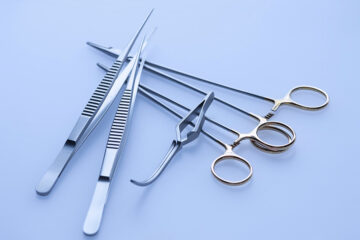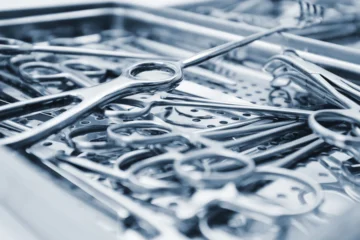Surgical scissors are precision instruments that play a crucial role in various surgical procedures, allowing surgeons to cut tissues, dissect anatomical structures, and perform delicate maneuvers with precision and accuracy. These essential tools are available in a wide range of types, sizes, and designs, each suited for specific tasks and procedures. In this comprehensive guide, we will explore the role and importance of surgical scissors in the operating room, their different types, uses, and best practices for maintenance.
The Role of Surgical Scissors in the Operating Room
Surgical scissors are versatile instruments used in a wide range of surgical procedures across different medical specialties. They are designed to cut tissues, sutures, and other materials with precision and control, allowing surgeons to perform delicate maneuvers and achieve optimal surgical outcomes.
Precision Cutting:
- Surgical scissors allow surgeons to make precise and controlled cuts, ensuring minimal trauma to surrounding tissues and structures.
- They are essential for dissecting tissues, cutting sutures, and performing intricate surgical tasks with accuracy.
Tissue Dissection:
- Surgical scissors are used to dissect and separate tissues, allowing surgeons to access the surgical site and perform procedures with ease.
- They are particularly useful in procedures that involve separating layers of tissue, such as abdominal surgeries and neurosurgical procedures.
Suture Removal:
- Surgical scissors are used to remove sutures and staples from wounds during post-operative care.
- They allow for precise cutting of sutures without causing trauma to the surrounding skin or tissue.
Hemostasis:
- Surgical scissors are used to achieve hemostasis by cutting and sealing blood vessels during surgical procedures.
- They are often used in conjunction with other instruments such as forceps and cautery devices to control bleeding.
Types of Surgical Scissors
Surgical scissors are available in a variety of types, sizes, and designs, each suited for specific tasks and procedures. Some common types of surgical scissors include:
1. Operating Scissors:
- Description: Operating scissors are general-purpose scissors used for cutting tissues, sutures, and other materials during surgical procedures.
- Features: They are available in various sizes and designs, including straight, curved, sharp-blunt, and blunt-blunt.
- Best for: General surgery, abdominal surgery, orthopedic surgery, and other procedures that require cutting and dissecting tissues.
2. Dissecting Scissors:
- Description: Dissecting scissors are designed for more delicate dissection and cutting of tissues, blood vessels, and other structures.
- Features: They feature finer tips and sharper blades than operating scissors, allowing for more precise cutting and dissecting.
- Best for: Neurosurgery, plastic surgery, ophthalmic surgery, and other procedures that require precise tissue dissection.
3. Tissue Scissors:
- Description: Tissue scissors are specifically designed for cutting soft tissues such as skin, muscle, and organs.
- Features: They feature sharp, pointed blades that allow for precise and clean cutting of tissues without causing trauma or damage to surrounding structures.
- Best for: Plastic surgery, reconstructive surgery, and other procedures that require precise tissue cutting.
4. Suture Scissors:
- Description: Suture scissors, also known as stitch scissors, are designed for cutting sutures and other materials used to close wounds.
- Features: They feature small, sharp blades with a curved or straight design for easy access to suture sites.
- Best for: Post-operative care, wound management, and other procedures that require suture removal.
5. Microsurgical Scissors:
- Description: Microsurgical scissors are designed for use in microsurgery and other delicate procedures that require precision and accuracy.
- Features: They feature extremely fine tips and sharp blades that allow for precise cutting and dissecting of small tissues and blood vessels.
- Best for: Ophthalmic surgery, neurosurgery, vascular surgery, and other procedures that require microsurgical techniques.
Importance of Proper Maintenance
Proper maintenance is essential to ensure the longevity and performance of surgical scissors. Follow these best practices for maintenance:
1. Cleaning:
- Immediate Cleaning: Clean surgical scissors immediately after use to prevent blood, tissue, and other debris from drying and adhering to the blades.
- Use Enzymatic Cleaners: Use enzymatic cleaners or detergents specifically designed for surgical instruments to remove organic debris and stains.
- Avoid Harsh Chemicals: Avoid using harsh chemicals, abrasive cleaners, or steel wool, as they can damage the blades and reduce the effectiveness of the scissors.
2. Sterilization:
- Autoclaving: Sterilize surgical scissors using steam autoclaving or other sterilization methods recommended by the manufacturer.
- Follow Manufacturer’s Instructions: Follow the manufacturer’s instructions for sterilization, including temperature, pressure, and cycle times, to ensure effective sterilization without damaging the scissors.
3. Lubrication:
- Regular Lubrication: Apply a thin layer of instrument lubricant to the screw joint and cutting edges of the scissors regularly to prevent corrosion and ensure smooth operation.
- Avoid Excess Lubrication: Avoid over-lubricating the scissors, as excess lubricant can attract dust, debris, and contaminants.
4. Inspection:
- Regular Inspection: Inspect surgical scissors regularly for signs of damage, wear, or corrosion, including bent or dull blades, loose screws, and rust spots.
- Replace Damaged Scissors: Replace any scissors that are damaged, worn, or no longer functioning properly to ensure safe and effective use.
5. Storage:
- Dry Storage: Store surgical scissors in a clean, dry environment to prevent corrosion and contamination.
- Avoid Contact with Other Instruments: Store surgical scissors separately from other instruments to prevent damage to the blades and cutting edges.
Conclusion
Surgical scissors are precision instruments that play a crucial role in various surgical procedures, allowing surgeons to cut tissues, dissect anatomical structures, and perform delicate maneuvers with precision and accuracy. By understanding the different types of surgical scissors available, their uses in different medical specialties, and best practices for maintenance, surgeons and operating room staff can ensure optimal performance and longevity of these important instruments. Proper care and maintenance of surgical scissors are essential to ensure safe and effective use and to protect the integrity of the instruments for years to come. With the right knowledge and practices, surgical scissors can continue to provide reliable performance and contribute to successful surgical outcomes.


